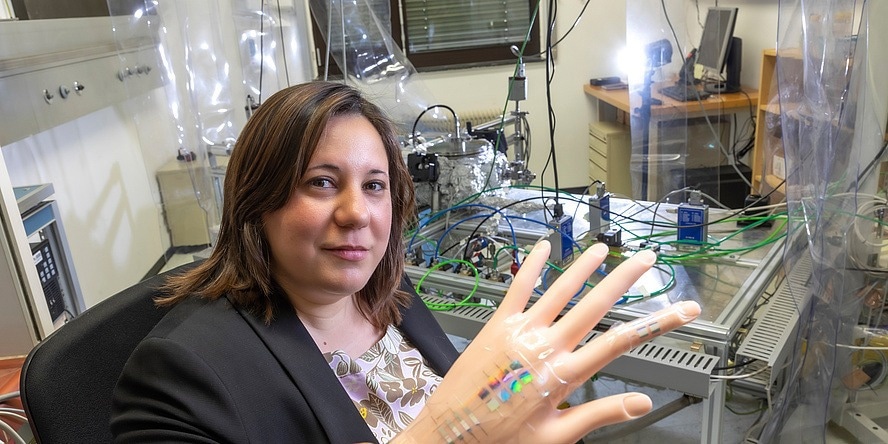
Anna Maria Coclite is the first researcher ever to win an ERC Proof of Concept grant at TU Graz. Image Credit: Lunghammer-TU Graz
Just a few months ago, Anna Maria Coclite and her research group from the Institute of Solid-State Physics at the Graz University of Technology (TU Graz) presented the outcomes of their study as part of Coclite’s ERC Starting Grant project “SmartCore.”
They had been successful in coming up with the three-in-one “smart skin” hybrid material, which closely matches human skin by sensing moisture, pressure, and temperature concurrently and thus converting them into electronic signals.
Having around 2,000 individual sensors per square millimeter, the hybrid material is more sensitive compared to a human fingertip and, at 0.006 mm thick, many times thinner compared to human skin.
By reacting to the three above-mentioned human sensory impressions, the smart skin transcends all electronic skin materials that are commercially available so far, which only react to temperature and pressure.
On the Way to Commercialization
European Research Council (ERC) Proof of Concept (PoC) Grants assist scientists who have already secured an ERC grant and who currently want to test their research outcomes for marketable innovation potential.
Beginning from the present prototype of the smart skin, the researcher wishes to make use of the PoC funding to come up with a wireless connection of the electronic skin to a real-time monitoring system.
This is done to transmit significant data on humidity, temperature, and pressure through Bluetooth to a smartphone app that could be utilized to display the recorded sensory impressions.
This constitutes a central additional development of the present still cumbersome wired electrical readout of the data and is a significant step towards making the smart skin benefits presentable to potential customers.
Industrial collaborators, like prosthetics companies, robot manufacturers, and medical device producers, are to be involved in the additional development of the smart skin at an early stage so that their needs can be considered accordingly.
We can take an important step towards a market launch of the smart skin with this EU funding. It will be exciting to see how the results of our basic research can find concrete application in monitoring, in the health sector or in robotics.
Anna Maria Coclite, Study First Researcher and Associate Professor, Institute of Solid State Physics, TU Graz University of Technology
Potential Areas of Application for The Smart Skin
There are several commercial applications available for the multisensory hybrid material developed at TU Graz. As per the World Health Organization (WHO), almost 200,000 people have been burned severely on an annual basis and have an entire loss of sensation as a result of the death of the skin receptors.
Smart skin could serve as a “plaster” to help burn victims get back their sensations. Also, it could help revolutionize the manufacture of smart prostheses. Modern prostheses reproduce movements and are—if feasible—connected to the nerve endings so that patients have the potential to control and move the robotic limb with their brain.
Smart skin has the potential to cover the prostheses and gather sensory information. As per the WHO estimate, nearly 30 million people across the world need a prosthesis.
The novel multisensory hybrid material has been utilized as a sensor with smartwatches and collects accurate data concerning the patient’s health status. In this approach, pH value, skin moisture, and temperature could be monitored constantly. It is a huge market, with around 216 million people wearing a smartwatch in 2022.
First Proof of Concept Grant for TU Graz
While Anna Maria Coclite was known to be the first woman to receive an ERC grant at TU Graz in 2016, she is currently the first researcher ever to win an ERC Proof of Concept grant at TU Graz. PoC grants from the European Research Council are contributed with 150,000 euros for an utmost of 18 months.
The research company Joanneum Research holds the patent for smart skin collectively with TU Graz and remains a significant research collaborator in the proof-of-concept project.